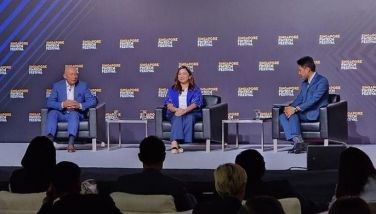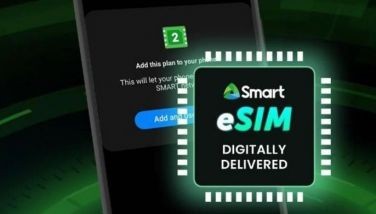Text2Teach: Making SMS relevant in education
May 28, 2005 | 12:00am
Text messaging may have transformed the way we communicate and even landed our country in the tech map as a nation of avid, no-nonsense texters. But cut the green jokes, the soppy greetings, the votes we send to win a prize, and those undying declarations of love and friendship, and the gossipy exchanges that last till the night.
Does text messaging have any practical uses as far as the more serious things in our national life are concerned? How far can a peso of text message go in terms of, say, untangling the traffic knot, depopularizing jueteng, diminishing street crime?
If we used text messages to gather people on EDSA in the last uprising that installed new leaders in our government, certainly, there must be some ways for this innovative technology to make an impact – in less dramatic, less political circumstances – on other areas of our public life that are begging for redemption.
In education, for one, academicians have long used interactive learning systems to enhance classroom teaching and bring quality education to the less privileged. But let’s get more practical, less dreamy. We are no Hollywood ready for blockbuster spending. Our needs our basic, very basic. As basic as our need to connect through text.
Hundreds of thousands of children attend public schools across the country, and in areas as widely dispersed as our rice and corn fields. If we have to use technology for educational purposes, it has to be the kind people are already familiar with and one that reaches even the farthest end of the archipelago.
At least, this was the idea of the proponents of the Text2Teach program of BridgeIT, a global ICT-based initiative which aims to narrow the educational divide between nations when it was launched in the summer of 2003.
Now on its third year, the program covers 204 public schools. An assessment of the first two years of its implementation has this to say of its impact: absenteeism was reduced among students attending Text2Teach classes, student performance was increased as gleaned by higher average scores in science, teacher-pupil, pupil-pupil interaction got a boost and there was a generally upbeat classroom environment.
Text2Teach classrooms are found in Quezon City, Batangas, Cotabato City, Oriental Mindoro, Antique, Cagayan de Oro, Maguindanao and North and South Cotabato, directly benefiting over 32,000 Grades 5 and 6 pupils.
The goal was simple: Bring multimedia education to public school classrooms in the Philippines using mobile technology, more specifically Short Messaging Service (SMS) or text messaging. The framework was even simpler: Text to download teaching materials – video, pictures, text or audio files – and you are ready to teach, or at least ready to provide a new classroom experience to elementary pupils who would otherwise not have access to these multimedia presentations. And this should work whether you are in Quezon City or in Maguindanao, or just at the foot of the Sierra Madre mountains, for as long your cellphone can get a signal.
One couldn’t say though that the implementation was that simple. It took the collaborative effort of a diverse group of players, including a corporate foundation, a telecommunications company, a broadcasting firm, a cellphone manufacturer, the Department of Education, an international funding institution and a curriculum developer.
In an interview with Telecoms, Jones Campos, head of public relations of Globe Telecom, one of the key players of the Text2Teach program, said the main challenge was to bring all these groups together to commit to a cause.
Luckily for the country, he said, BridgeIT chose the Philippines as the pilot site for the program because of the popularity of text messaging here and our quite legendary propensity to text. Campos said Globe Telecom alone has 95 percent population coverage with more than 4,000 cell sites nationwide.
"So the technology is easy to deploy. The infrastructure was already there," he said.
Jeffrey Ochoa Tarayao, community relations head of the public relations division of Globe Telecom, explained that at the classroom level, two things are needed to use the Text2Teach module – a mobile phone for the teacher and a TV set-top box in the classroom.
Picture a science class in a remote barrio in Maguindanao. The topic for the day is volcano. Ms. X texts the word volcano to a dedicated Globe number, which automatically sends the request to the Text2Teach video library which, in turn, sends the module on volcanoes via satellite to the classroom that requested for it. The teacher downloads the module and the class begins.
The day’s topic, however, is not dependent on the mood of the teacher or what the class wants to watch, but follows a curriculum defined by the Department of Education (DepEd). There are 80 video modules in the electronic library on topics that are generally discussed in Grade 5 and 6 science and math classes.
Three years into the program and Tarayao said there are many things that Text2Teach has to revise, fine-tune or re strategize to make it work and make it more relevant.
First is in the area of content. Since the modules were provided by Pearson, an American education company that publish textbooks, multimedia programs and online services, the video modules are highly foreign, Tarayao said. "If they study mountains, for example, what they get is a video of Mount McKinley and not Mount Pinatubo or Mt. Mayon," he quipped.
Starting this year though, local materials produced by Southeast Asian Association Ministries of Education Organizations (SEAMEO-Innotech), based in the Philippines, will be included in the program, including video modules on values education.
SEAMEO-Innotech acts as the overall project coordinator for lesson development, training, monitoring and linkages at the field level.
Starting this year, Tarayao said that in addition to science and math video modules, Text2Teach classrooms will also be provided with modules on the English language.
Since the program is progressive, one of the things that DepEd requires in schools for inclusion in the Text2Teach program is the familiarity of the teachers with the technology and their being receptive to this innovative teaching facility.
And it has to involve the whole school, said Tarayao, because other subject areas may be included in the program later on.
With 38,000 public elementary schools all over the Philippines, only 204 have Text2Teach facilities, a drop in a bucket, literally.
Although the program’s proponents would like to make it more pervasive, it has to chart the program in measured steps because of the cost involved. Campos said the TV set-top box given to schools alone, called the Nokia media master, cost P80,000 each and was provided by Nokia for free.
For the first phase of the program, Nokia also provided cellphones to the schools. On the second phase, Globe Telecom shouldered the handset cost. And this year, Globe and Nokia split the cost of the handsets 50-50. Each school also gets a P150 load per month from Globe.
The good thing though, Campos said, is that for the third phase of the program, the cost of the project for all schools, except for the telecom cost, was shouldered by the US Agency for International Development (USAID), under the auspices of its Education and Livelihood Skills Alliance (ELSA) program.
More entities are actually coming into the program, complementing the efforts of the original proponents, which include PMSI-Dream Broadcasting, whose satellite facilities are used to beam the video modules to the classrooms; Chikka Asia, which developed the interface from text to satellite to download the video modules; the Ayala Foundation, the International Youth Foundation and the United Nations Development Program (UNDP).
USAID’s ELSA, for instance, is a public-private partnership that is now very active in Mindanao, especially in the Autonomous Region in Muslim Mindanao (ARMM), working to expand school-based and community-based learning.
Much has been said about the convergence of technologies, which is now the buzzword in the global information and communications technology (ICT) arena. But as applied to efforts in the educational sector, especially in the context of realities in a developing country, convergence actually breathes life to that old African proverb "it takes a village to raise a child."
As technologies move forward, none can actually lay claim to having the exclusive expertise of offering a complete solution to a societal undertaking like Text2Teach.
Text2Teach is actually a product of a complex socio technical ecosystem that crosses industries and technical platforms. It is also an offshoot of current mobile technology applications that are sweeping the education sector.
In selected campuses nationwide, students, for example, can already enroll through texting, inquire their tuition balance, receive news alerts and campus bulletins on their cellphones, and vote for their student council leaders through text.
It won’t be long, Campos said, for students to also start paying their tuition through their cellphones.
But Campos was quick to point out that the proponents of Text2Teach do not have plans of offering the service commercially to private schools or private individuals.
"This is really a philantrophic endeavor," he said.
Then let it be said that SMS is coming full circle in this cellphone-crazy nation. That P1 text message can build friendships, enhance relationships or make communications more efficient. And yes, it can also open a child’s eyes to scientific concepts and ideas that he otherwise may not have the chance to explore.
Does text messaging have any practical uses as far as the more serious things in our national life are concerned? How far can a peso of text message go in terms of, say, untangling the traffic knot, depopularizing jueteng, diminishing street crime?
If we used text messages to gather people on EDSA in the last uprising that installed new leaders in our government, certainly, there must be some ways for this innovative technology to make an impact – in less dramatic, less political circumstances – on other areas of our public life that are begging for redemption.
In education, for one, academicians have long used interactive learning systems to enhance classroom teaching and bring quality education to the less privileged. But let’s get more practical, less dreamy. We are no Hollywood ready for blockbuster spending. Our needs our basic, very basic. As basic as our need to connect through text.
Hundreds of thousands of children attend public schools across the country, and in areas as widely dispersed as our rice and corn fields. If we have to use technology for educational purposes, it has to be the kind people are already familiar with and one that reaches even the farthest end of the archipelago.
At least, this was the idea of the proponents of the Text2Teach program of BridgeIT, a global ICT-based initiative which aims to narrow the educational divide between nations when it was launched in the summer of 2003.
Now on its third year, the program covers 204 public schools. An assessment of the first two years of its implementation has this to say of its impact: absenteeism was reduced among students attending Text2Teach classes, student performance was increased as gleaned by higher average scores in science, teacher-pupil, pupil-pupil interaction got a boost and there was a generally upbeat classroom environment.
Text2Teach classrooms are found in Quezon City, Batangas, Cotabato City, Oriental Mindoro, Antique, Cagayan de Oro, Maguindanao and North and South Cotabato, directly benefiting over 32,000 Grades 5 and 6 pupils.
One couldn’t say though that the implementation was that simple. It took the collaborative effort of a diverse group of players, including a corporate foundation, a telecommunications company, a broadcasting firm, a cellphone manufacturer, the Department of Education, an international funding institution and a curriculum developer.
In an interview with Telecoms, Jones Campos, head of public relations of Globe Telecom, one of the key players of the Text2Teach program, said the main challenge was to bring all these groups together to commit to a cause.
Luckily for the country, he said, BridgeIT chose the Philippines as the pilot site for the program because of the popularity of text messaging here and our quite legendary propensity to text. Campos said Globe Telecom alone has 95 percent population coverage with more than 4,000 cell sites nationwide.
"So the technology is easy to deploy. The infrastructure was already there," he said.
Jeffrey Ochoa Tarayao, community relations head of the public relations division of Globe Telecom, explained that at the classroom level, two things are needed to use the Text2Teach module – a mobile phone for the teacher and a TV set-top box in the classroom.
Picture a science class in a remote barrio in Maguindanao. The topic for the day is volcano. Ms. X texts the word volcano to a dedicated Globe number, which automatically sends the request to the Text2Teach video library which, in turn, sends the module on volcanoes via satellite to the classroom that requested for it. The teacher downloads the module and the class begins.
The day’s topic, however, is not dependent on the mood of the teacher or what the class wants to watch, but follows a curriculum defined by the Department of Education (DepEd). There are 80 video modules in the electronic library on topics that are generally discussed in Grade 5 and 6 science and math classes.
First is in the area of content. Since the modules were provided by Pearson, an American education company that publish textbooks, multimedia programs and online services, the video modules are highly foreign, Tarayao said. "If they study mountains, for example, what they get is a video of Mount McKinley and not Mount Pinatubo or Mt. Mayon," he quipped.
Starting this year though, local materials produced by Southeast Asian Association Ministries of Education Organizations (SEAMEO-Innotech), based in the Philippines, will be included in the program, including video modules on values education.
SEAMEO-Innotech acts as the overall project coordinator for lesson development, training, monitoring and linkages at the field level.
Starting this year, Tarayao said that in addition to science and math video modules, Text2Teach classrooms will also be provided with modules on the English language.
Since the program is progressive, one of the things that DepEd requires in schools for inclusion in the Text2Teach program is the familiarity of the teachers with the technology and their being receptive to this innovative teaching facility.
And it has to involve the whole school, said Tarayao, because other subject areas may be included in the program later on.
With 38,000 public elementary schools all over the Philippines, only 204 have Text2Teach facilities, a drop in a bucket, literally.
Although the program’s proponents would like to make it more pervasive, it has to chart the program in measured steps because of the cost involved. Campos said the TV set-top box given to schools alone, called the Nokia media master, cost P80,000 each and was provided by Nokia for free.
For the first phase of the program, Nokia also provided cellphones to the schools. On the second phase, Globe Telecom shouldered the handset cost. And this year, Globe and Nokia split the cost of the handsets 50-50. Each school also gets a P150 load per month from Globe.
The good thing though, Campos said, is that for the third phase of the program, the cost of the project for all schools, except for the telecom cost, was shouldered by the US Agency for International Development (USAID), under the auspices of its Education and Livelihood Skills Alliance (ELSA) program.
More entities are actually coming into the program, complementing the efforts of the original proponents, which include PMSI-Dream Broadcasting, whose satellite facilities are used to beam the video modules to the classrooms; Chikka Asia, which developed the interface from text to satellite to download the video modules; the Ayala Foundation, the International Youth Foundation and the United Nations Development Program (UNDP).
USAID’s ELSA, for instance, is a public-private partnership that is now very active in Mindanao, especially in the Autonomous Region in Muslim Mindanao (ARMM), working to expand school-based and community-based learning.
As technologies move forward, none can actually lay claim to having the exclusive expertise of offering a complete solution to a societal undertaking like Text2Teach.
Text2Teach is actually a product of a complex socio technical ecosystem that crosses industries and technical platforms. It is also an offshoot of current mobile technology applications that are sweeping the education sector.
In selected campuses nationwide, students, for example, can already enroll through texting, inquire their tuition balance, receive news alerts and campus bulletins on their cellphones, and vote for their student council leaders through text.
It won’t be long, Campos said, for students to also start paying their tuition through their cellphones.
But Campos was quick to point out that the proponents of Text2Teach do not have plans of offering the service commercially to private schools or private individuals.
"This is really a philantrophic endeavor," he said.
Then let it be said that SMS is coming full circle in this cellphone-crazy nation. That P1 text message can build friendships, enhance relationships or make communications more efficient. And yes, it can also open a child’s eyes to scientific concepts and ideas that he otherwise may not have the chance to explore.
BrandSpace Articles
<
>
- Latest
Latest
Latest
February 22, 2024 - 3:17pm
February 22, 2024 - 3:17pm
December 11, 2023 - 11:00am
December 11, 2023 - 11:00am
November 23, 2023 - 4:35pm
November 23, 2023 - 4:35pm
October 16, 2023 - 5:00pm
October 16, 2023 - 5:00pm
Recommended






























